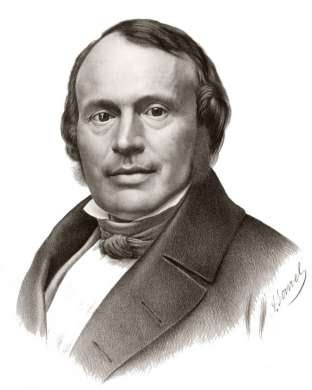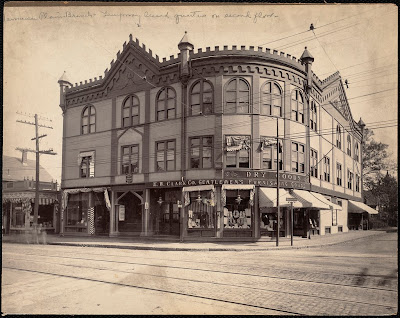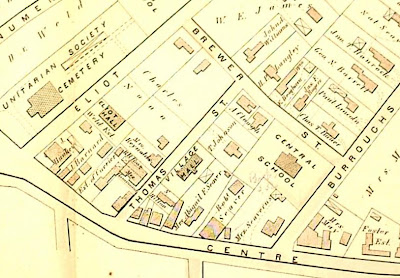
In 1896, two new grammar schools were opened in Jamaica Plain: The Bowditch for girls and the Louis Agassiz for boys. The Agassiz was located at the corner of Burroughs and Brewer streets, behind a Centre street commercial block. So who was Louis Agassiz, and why was this school in particular named for him? I can't say for sure - no records were kept - but I will propose an answer with some confidence.

Louis Agassiz school, Brewer and Burroughs streets.
Louis Agassiz was born in 1807 French-speaking Switzerland, and was educated broadly in Natural History - what we would call botany and zoology, or simply biology. After studying new fish species early in his career, he shifted to the new fish fossils that were being found at the time. He soon became a world leader in both modern and paleo-ichthyology.
In spite of his fame in these fields, Agassiz is best known today for being the leading proponent of the then-new idea that there had, in the past, been Ice Ages, in which much of the Northern Hemisphere was covered in vast sheets of ice. This Agassiz deduced from his home country, where glaciers still covered mountainsides, and evidence of past, larger glaciers were spread through the countryside. For a culture with no clear idea how old the world was - outside the six thousand-odd years of Biblical history - this idea was beyond ground-breaking.
In 1846, Agassiz traveled to the United States to study the natural history of North America and to give a series of lectures at the Lowell Institute in Boston. Once here, he was offered a job at Harvard, and became founder of Museum of Comparative Zoology and taught a generation of scientists. Posterity has not been so kind to Agassiz in remembering him as one of the leading scientific anti-evolutionists of his day - Agassiz and Darwin looking at the same evidence and seeing very different causes. In the 1860s, Agassiz returned to his study of South American fishes, going on months-long voyages to see his subjects in their natural habitats. He passed away in 1873, one of the country's and the world's most famous scientists.
So now we know something of Louis Agassiz's fame. But why was this particular school in Jamaica Plain named in his honor in 1896? Perhaps the answer is simple as his fame, but there is more to the story. The first Agassiz connection is a slender thread, but an interesting one. During the mid-19th Century, a Village Hall was built on Thomas street near Centre street. The building had various uses over the years, serving as a schoolhouse and a Grand Army of the Republic meeting hall, but it was also used to house lecture series for the public at a time when educational talks on scientific and literary subjects had broad popularity. In her Reminiscences of Jamaica Plain, 1845-1875, Ellen Morse describes just such a visit by the great Louis Agassiz:
"Distinguished lecturers came then to the platform of the old hall, Mr. Homes and Professor Agassiz being among those whom some of the boys and girls of those days remember most vividly. Professor Agassiz' benevolent, kindly face and his broken English gave him great charm, even if we couldn't follow much of his scientific instruction. What a privilege it was to hear such men in those days when they traveled all over the country to deliver their fine lectures! How did they ever survive the long journeys in stagecoaches and the resting places in country hotels and cold bed-chambers?"
So the Man Himself spoke in Jamaica Plain within a stone's throw of the future site of the eponymous school. Interesting, but there is much more to the story.
In 1850, Agassiz married Elizabeth Cabot Cary, an educator who would be a co-founder and first president of Radcliffe College. Their daughter Pauline would marry Quincy Adams Shaw, who became one of the richest men in Massachusetts through his investment in the Calument and Hecla copper mine in Michigan. The Shaws settled on an estate overlooking Jamaica Pond on Perkins street. Pauline, already discussed in an entry here, used her wealth to aid many progressive causes, including the establishments of Boston's first Kindergartens.
So Pauline Agassiz Shaw, daughter of the great man, wife of one of the state's leading businessmen, and famed philanthropist in her own right, was a resident of the community at the time the school was built - and named. In fact, one of the first of her kindergartens was located in the very Village Hall where her father had lectured years earlier. Isn't it reasonable to speculate that the school could have been named in her father's honor as a respectful tip of the hat to Mrs Shaw as well? As I said, there can be no proof, but the story sits together well. It's my story, and I'm sticking to it.
Sadly, the 'new' Agassiz school on Child street is now slated to be closed, and the name Louis Agassiz will no longer be honored in Boston. In this, Agassiz joins a long list of those lost to posterity in the Boston school systems massive down-sizing since the baby-boom years of the 1960s. The stories of all those whose names have been lost would fill a book, and the loss to Boston history is sad indeed.
*In a final note, I can't discuss Louis Agassiz without using the 'R'-word. I was reading a local internet comment section recently, where the name Agassiz had come up. One of the commenters asked if the readers knew that Agassiz was "one of history's most notorious racists." Granted that the internet is the land of hyperbole - and ignorance - but this kind of thing needs correcting. There will be no more Jamaica Plain content - the following is an effort to get this matter off my chest. Please feel free to ignore it.
Louis Agassiz's name and fame have long passed from public knowledge - 19th Century Natural Historians are not on the tips of contemporary American's tongues. Outside of those interested in paleontology, geology and ichthyology, the man was barely known in this country outside his adopted Cambridge and in Jamaica Plain - and even there, he was less a man than a label for a building. So where did the commenter I cited get his/her information?
Stephen Jay Gould was a paleontologist, head of the same Harvard museum as Agassiz had founded, and a prolific writer of popular science articles and books. It was Gould who found letters written by Agassiz and published quotes from then one hundred years after the man had died. The 'money quote' from Agassiz was a description of an encounter with an African-American waiter in a restaurant. Agassiz tells of a visceral response to his close encounter with this African man - he describes the man in as ugly terms as we could imagine.
So what do we do with such information? At the time Gould's book was released, there were calls to rename schools named after Agassiz. While Boston resisted, the City of Cambridge did so, renaming its Agassiz school in honor of an African-American, presumably to make amends. Should Boston have done the same thing? I think not.
The truth is, in the mid-19th Century, essentially all white people were racists. Abraham Lincoln was a racist, as was Charles Darwin. While white people disagreed over how to treat the races of the world, vanishingly few believed literally that all men were created equal in the biological sense. Indeed, unless we are willing to cut off history's honors at 1965, it's hard to imagine finding more than a handful of racism-free heroes out of all of Western civilization.
Right through the turn of the 20th Century, the Western scientific world held that Caucasians were biologically superior to all other races - a fact that Stephen Jay Gould himself made a minor career out of discussing. In fact, that same Western intellectual elite - and its contemporary butchers, bakers and candlestick makers - believed equally that women (of all races) shared a similar biological inferiority to blacks and other races. Again, Gould makes much of this fact in his columns and books.
Given these facts, I find it hard to pick out Louis Agassiz for opprobrium. Was he a racist? Yes - guilty as charged. He was, however, a man of his time. All of the scientists of his day shared his beliefs to some degree, and to judge him by our contemporary morality is to be guilty of anachronistic history. An examination of his personal beliefs and how they informed his work is a worthwhile endeavor, more for what it may tell us about ourselves than for any pleasure we may get from looking down our noses on him.
Louis Agassiz was one of the great men of his age - warts and all. All heroes have feet of clay, and we point an accusing finger at one at our own risk. Do we really want our own heroes examined so closely? Men like Agassiz and Thomas Jefferson were poisoned by the racist beliefs of their days. At their best, they were also great men, worthy of honor. A maturity that both recognizes their flaws and honors their virtues does honor to ourselves. And some day, our time will be judged as we judge the past. And like them, we have little idea what it is about us that will be found so revolting by our descendants. We can only rest assured that there will be demands that the names of our contemporary heroes be removed from places of public honor.
Note: Commenter Jim adds this.
"One correction, please, Pauline was born to Louis Agassiz's first wife, whose maiden name was Cecile Braun (1809 - 1848). "







